Affordable Roof Installation Without Compromising Quality
A roof installation is a major investment that protects your home from weather damage while improving curb appeal and energy efficiency. Finding quality roofing services at a reasonable price requires understanding cost factors, material options, and contractor selection.
Key roof installation facts:
- Average cost: $8,000 nationally (range: $5,500-$11,000)
- Timeline: Most residential roofs are completed in 1-3 days
- Cost breakdown: Materials account for 40%, while labor accounts for 60%
- ROI: A quality roof replacement returns approximately 60% of its investment at resale
- Lifespan: Asphalt shingles last 20-25 years; metal roofs last 50-75 years
The national average cost to replace a roof is around $8,000, but costs vary based on roof size, material, and local labor rates. Understanding this breakdown helps homeowners make informed decisions. Whether you need a full replacement or targeted repairs, working with experienced professional roofing contractors ensures proper installation and long-term protection.
I’m Tim Whiting, owner of Whiting Co. Roofing & Exteriors. With nearly 50 years of trusted service, our team has delivered roof installation and exterior solutions to over 25,000 homeowners in Maryland, D.C., and Virginia, specializing in projects that protect your home investment.
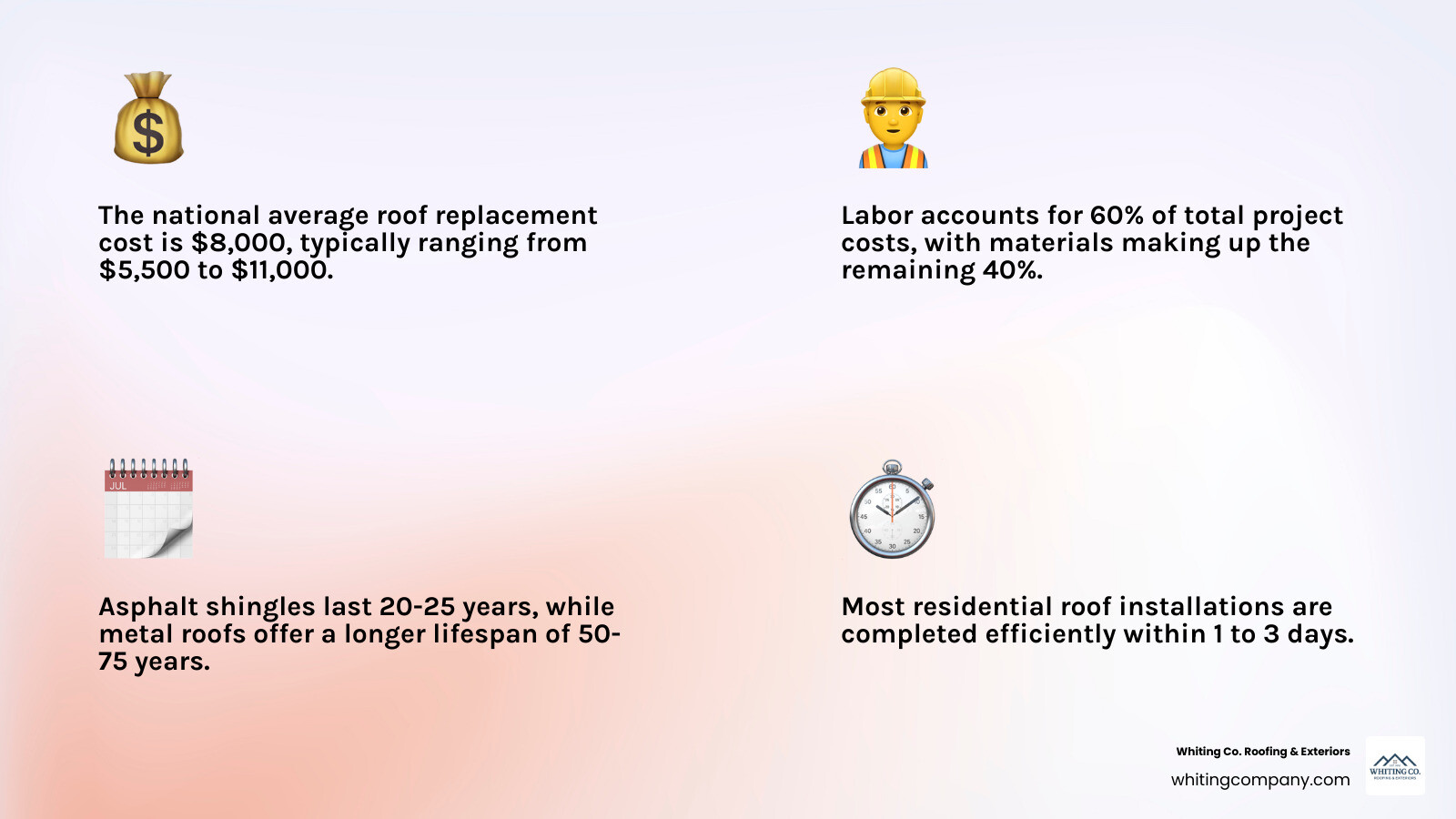
Roof Replacement Costs Explained: What Homeowners Should Expect
Understanding the costs of a new roof is a critical first step. While the national average for a roof replacement is around $8,000, with most projects falling between $5,500 and $11,000, your exact costs will vary. Premium materials like metal can increase the price significantly. At Whiting Co., we provide transparent, competitive estimates to ensure you receive great value.
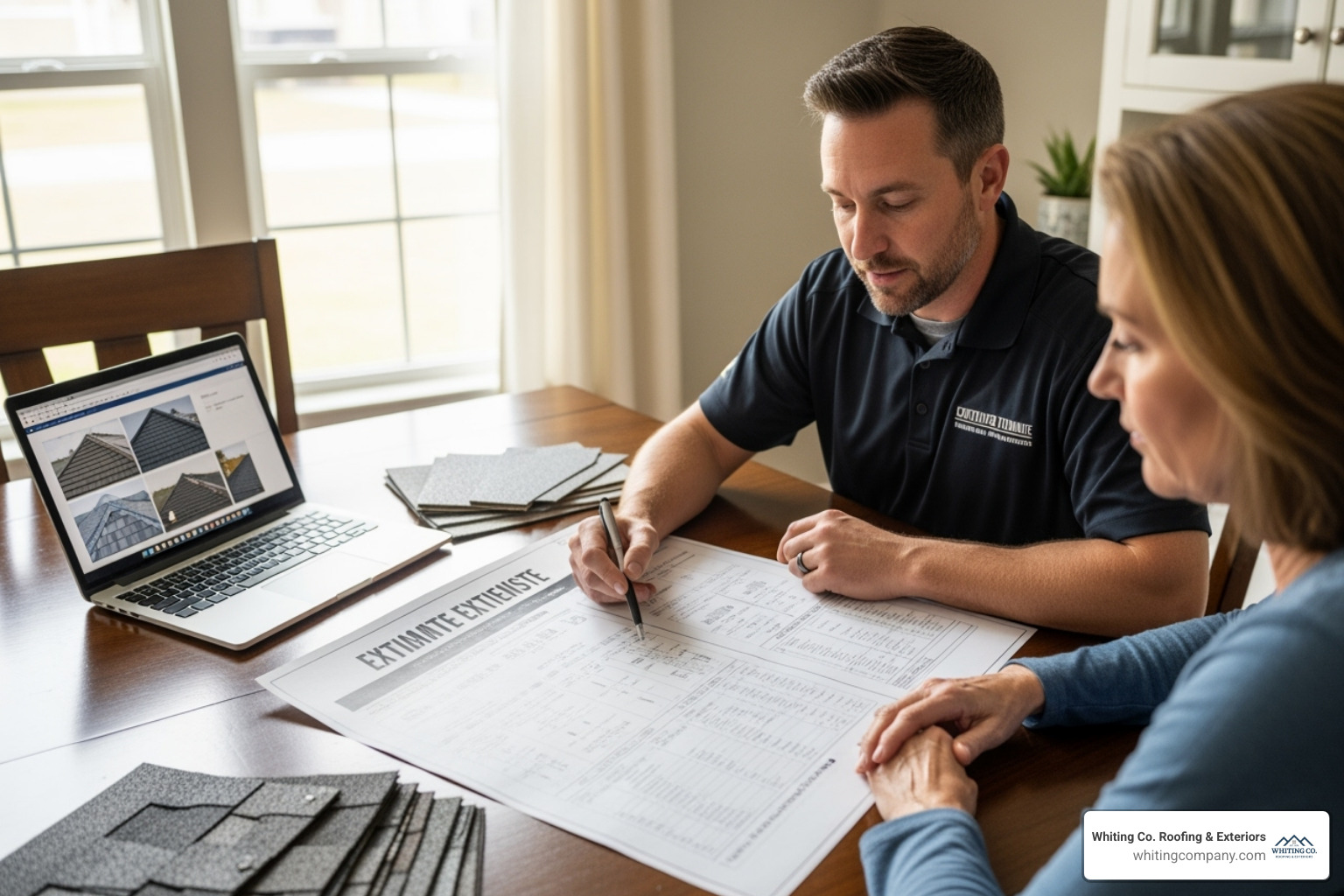
What Factors Influence the Price of a New Roof?
The final price for your roof installation depends on several key factors:
- Roof Size and Complexity: Larger roofs require more materials and labor. A steep pitch, multiple valleys, or dormers also increase labor costs due to the need for specialized skills and safety equipment.
- Material Selection: Materials account for about 40% of the total cost, but prices vary widely. Basic asphalt shingles cost around $100 per square (100 sq. ft.), while premium options can exceed $1,000 per square.
- Labor Costs: Labor typically makes up 60% of the project total. This covers the skilled professionals who tear off the old roof and install the new system, with rates varying by region and job complexity.
- Old Roof Removal (Tear-Off): Removing the existing roof adds to labor and disposal costs, especially if multiple layers are present.
- Decking Repair: If the wooden deck beneath your old roof is rotted or damaged, it must be repaired or replaced for structural integrity. This adds to the project’s expense but is vital for long-term performance.
- Permit Fees and Debris Disposal: Most municipalities require permits to ensure compliance with building codes. Costs for dumpsters and debris disposal also contribute to the final price.
The Return on Investment (ROI) of a New Roof
A new roof is a smart financial move, returning around 60% of its value at resale, according to real estate experts. A new roof also boosts curb appeal, making your home more attractive to buyers, and can lead to energy savings through improved insulation and modern materials.
At Whiting Co., we provide detailed estimates so you feel confident about your investment. We’ll work with you to find solutions that fit your budget without compromising quality.
Ready to protect your home with a high-quality new roof? Learn more about our Roof Replacement services and let’s discuss how we can help.
Repair or Replace? How to Make the Most Cost-Effective Roofing Decision
Deciding whether to repair or replace your roof is a crucial decision. While targeted repairs can fix minor issues, a complete roof installation is often the most cost-effective solution for widespread damage. Understanding the key warning signs can save you money and prevent severe water damage. At Whiting Co., we provide honest inspections to help you make the best long-term investment for your home.
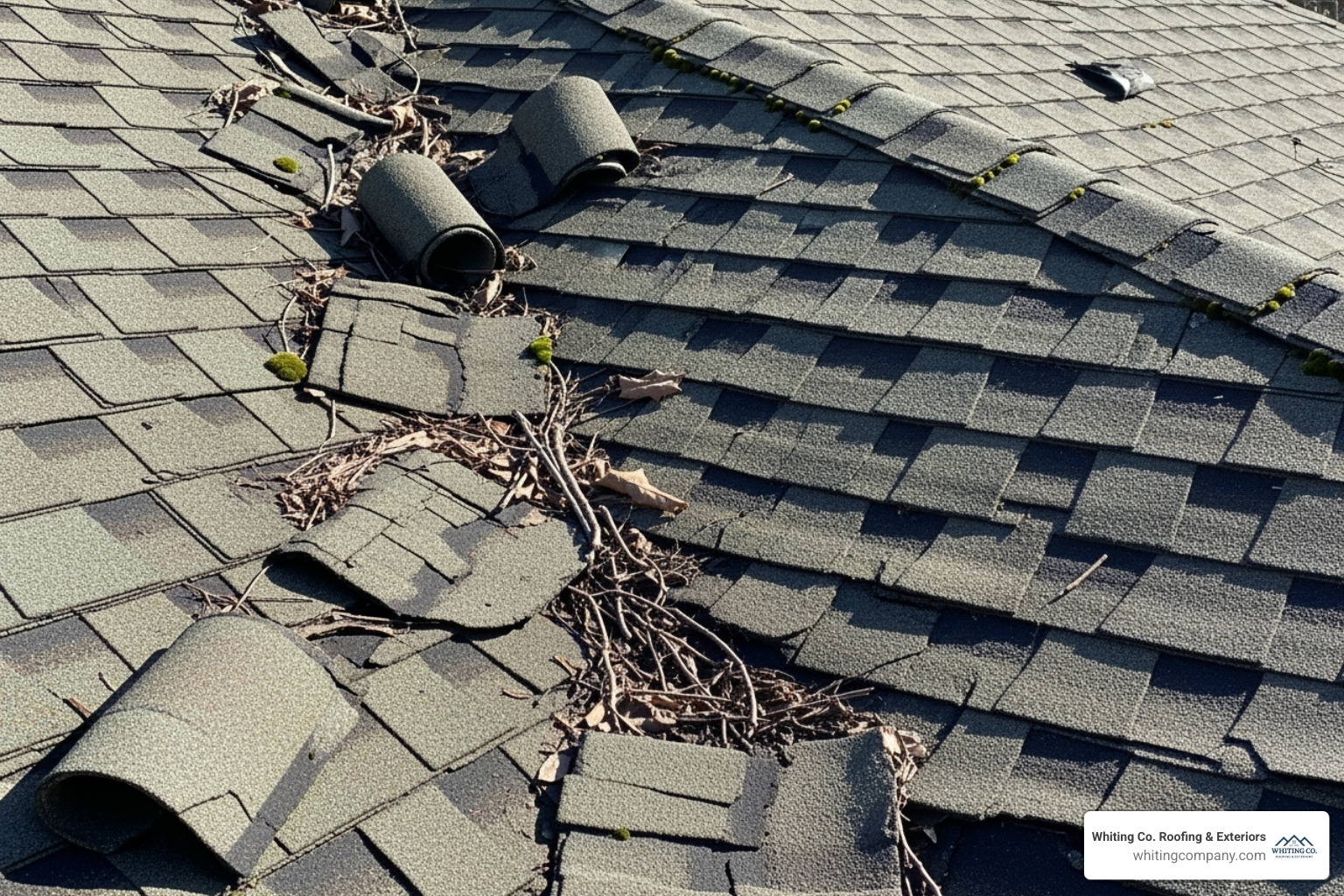
Definitive Signs Your Roof Needs Replacement
While small repairs for a few loose shingles may cost $350-$1,000, the following signs indicate a replacement is necessary:
- Advanced Age: If your roof is over 20-25 years old, its materials are likely nearing the end of their lifespan, even if it looks acceptable from the ground.
- Curling, Buckling, or Missing Shingles: When shingles curl or buckle, their protective seal is broken, leaving your home vulnerable to water. Widespread shingle loss indicates adhesive failure across the roof.
- Widespread Granule Loss: The granules on asphalt shingles protect them from UV rays. If you find large amounts in your gutters or see bare spots, the roof’s protective layer is compromised.
- Damaged Flashing or Sagging Structure: Damaged flashing around chimneys and vents creates entry points for water. A sagging roof deck is a sign of serious structural issues or long-term water damage that requires immediate replacement.
- Evidence of Water Damage: Stains on ceilings, moisture in the attic, or multiple leaks are clear signs your roof is failing. At this point, replacement is more cost-effective than numerous repairs.
When your roof shows multiple warning signs, a new roof installation offers better value and peace of mind. For a detailed analysis, see our guide on Signs Your Roof Needs Repair. Whether you need targeted fixes via our Roof Repair services or a full replacement, our team provides assessments that prioritize your home’s protection.
The Professional Roof Installation Process: Step-by-Step Overview
A professional roof installation follows a meticulous process to ensure long-term protection. At Whiting Co., we’ve refined this system over nearly 50 years, completing most residential projects in just 1-3 days.
Deck Preparation and Underlayment Installation
The foundation of a durable roof is built before any shingles are installed.
- Old Roof Removal: We strip away all old roofing materials to inspect the underlying structure.
- Decking Inspection: We examine the roof deck for rot or damage, replacing compromised sections to ensure a solid base for the new roof.
- Drip Edge Installation: This metal flashing is installed along the eaves to direct water away from the fascia.
- Ice and Water Shield: A self-adhering waterproof membrane is applied to the most vulnerable areas, like valleys and eaves, to prevent leaks from ice dams and driving rain.
- Synthetic Underlayment: The entire roof deck is covered with a modern synthetic underlayment, which provides a superior moisture barrier.
Flashing and Ventilation: Critical for Leak Prevention
Proper flashing and ventilation are essential for a leak-free roof.
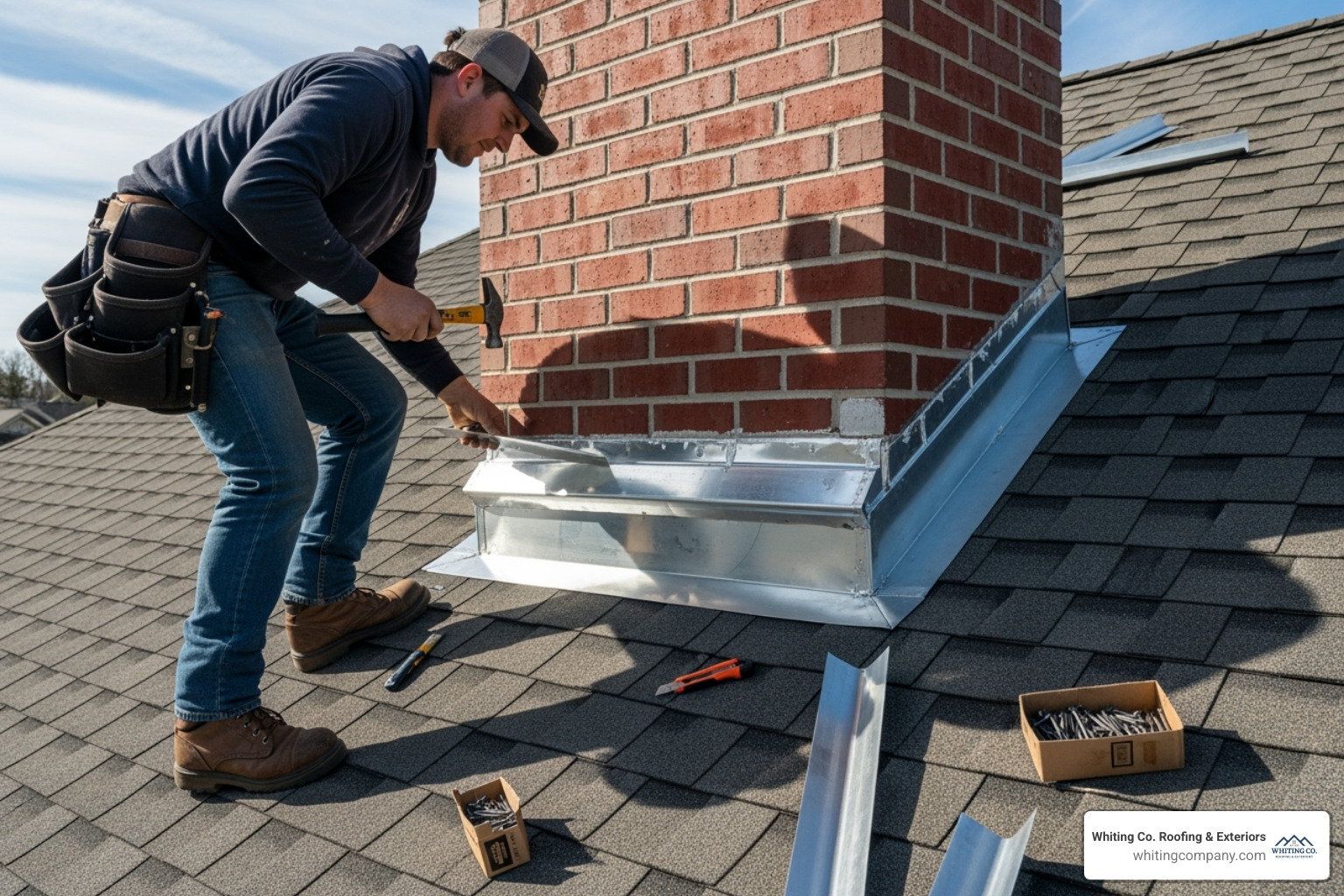
- Flashing: We install custom flashing—including step, valley, and vent pipe flashing—around chimneys, dormers, and other penetrations to create watertight seals.
- Ventilation: A balanced system of soffit vents (intake) and ridge vents (exhaust) allows for continuous airflow. This prevents moisture buildup in the attic and reduces energy costs.
Asphalt Shingle Installation: Key Steps for Lasting Results
The final shingle application requires precision for maximum durability and weather resistance.
- Starter Shingles: A special course of shingles is installed at the eaves to provide a secure base and improve wind resistance.
- Field Shingle Installation: Shingles are installed from the bottom up, with staggered seams to prevent water infiltration. We use a precise five nails per shingle pattern for optimal hold.
- Hip and Ridge Capping: Specially designed cap shingles are installed on the hips and ridges of the roof, which are high-stress areas. You can watch a demonstration of hip and ridge capping to see this final step.
- Sealing: All exposed nail heads are sealed with a durable, weather-resistant sealant to prevent leaks.
This methodical approach ensures every roof installation we complete provides decades of reliable protection.
Roofing Materials Compared: Cost, Lifespan, and Curb Appeal
Selecting the right material is a critical decision in your roof installation. It impacts cost, longevity, and curb appeal. At Whiting Co., we help Maryland homeowners choose the best material for their budget, home style, and our local climate.
- Asphalt Shingles: As the most popular choice, asphalt shingles offer excellent value at $100 to $300 per square with a 20-25 year lifespan. They come in many styles and colors but can be susceptible to wind damage and granule loss over time.
- Metal Roofing: A premium option costing $400 to over $1,000 per square, metal roofs last 50-75 years. They are extremely durable, energy-efficient, and low-maintenance, making them a great long-term investment.
- Cedar Shakes: Offering best natural beauty, cedar shakes cost $400 to $800 per square and last 20-25 years. They provide good insulation but require regular maintenance to prevent rot and moss, especially in humid climates.
- Rubber Roofing (EPDM): Ideal for flat or low-slope roofs, rubber costs $300 to $600 per square and has a 30-50 year lifespan. It is highly durable and requires minimal maintenance.
| Material Type | Cost per Square | Lifespan | Key Benefits | Climate Notes |
|---|---|---|---|---|
| Asphalt Shingles | $100-$300 | 20-25 years | Affordable, versatile styles | Good for most climates |
| Metal Roofing | $400-$1,000+ | 50-75 years | Energy efficient, ultra-durable | Excellent for all weather |
| Cedar Shakes | $400-$800 | 20-25 years | Natural beauty, good insulation | Requires humid climate care |
| Rubber Roofs | $300-$600 | 30-50 years | Low maintenance, flat roof ideal | Excellent weather resistance |
When choosing, consider both upfront cost and long-term value. A metal roof’s longevity can make it more cost-effective over time than multiple asphalt roof replacements. Data on the most common roofing materials and their life-expectancy confirms these ranges.
Ready to explore your options? Our roofing materials page showcases the full range of products we install.
Homeowner Checklist: Preparing for a Smooth Roof Installation Day
Proper preparation for your roof installation ensures the project runs smoothly and safely. A few simple steps can protect your property and minimize disruption.
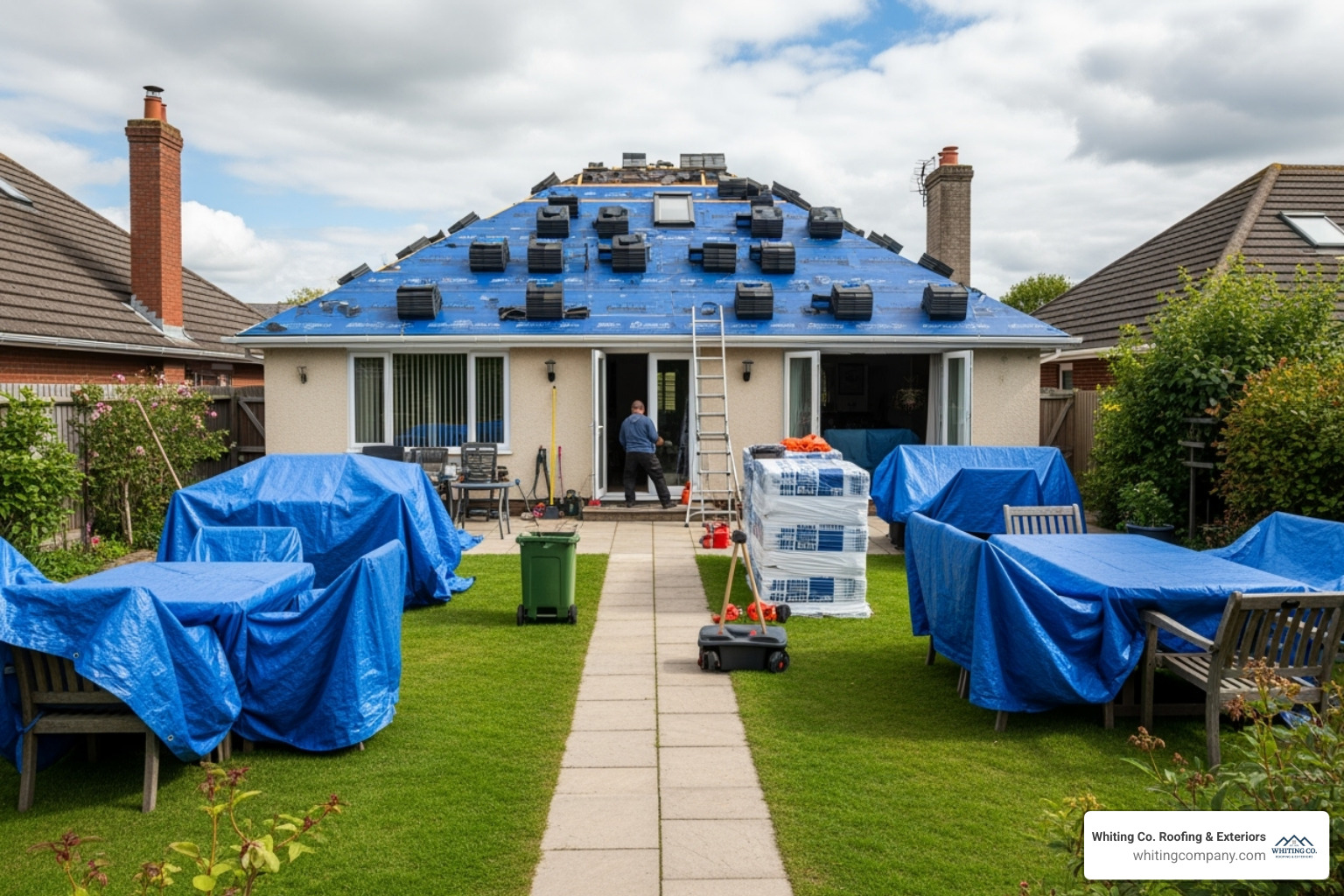
Protecting Your Property
- Clear Access: Move all vehicles from the driveway to the street to allow access for our trucks and dumpster.
- Protect Landscaping: Move patio furniture, grills, and potted plants at least 15 feet from the house. Cover delicate shrubs or flower beds with tarps.
- Mark Fixtures: Use flags to mark sprinkler heads and landscape lighting to prevent accidental damage.
- Mow Your Lawn: A short lawn makes it easier for our crew to find and remove stray nails during the final magnetic sweep.
Preparing Your Home’s Interior
- Remove Wall Hangings: Vibrations can cause items like pictures and mirrors to fall. Remove them from walls, especially on the upper floors.
- Secure Fragile Items: Move delicate collectibles and glassware away from exterior walls.
- Protect Attic Contents: Cover items stored in the attic with tarps to protect them from dust and small debris.
Managing Disruptions
- Plan for Noise: A roof installation is loud. Keep children and pets indoors and away from the work area for their safety. Consider planning a day trip for noise-sensitive family members or pets.
- Notify Neighbors: A quick heads-up about the project timeline is a courteous gesture that can prevent complaints.
Final Steps
- Provide Power: Ensure an exterior electrical outlet is accessible for our crew’s power tools.
- Final Walk-Through: After the installation and cleanup, walk the property with our project manager to ask questions and inspect the finished work.
Why Professional Installation Beats DIY: Safety, Quality, and Value
While DIY roof installation may seem like a way to save money, it is one of the most dangerous and technically demanding home improvement projects. The risks often lead to costly mistakes that far outweigh any initial savings.
The Risks of DIY Roof Installation
According to the Bureau of Labor Statistics, roofing is one of the most hazardous jobs. The dangers of DIY roofing for untrained homeowners are even greater.
- Serious Injury: Without professional safety training and equipment, the risk of life-threatening falls is extremely high.
- Improper Installation: Mistakes like incorrect nailing or poor flashing lead to leaks and water damage that can cost thousands to repair.
- Voided Warranties & Insurance: DIY work typically voids manufacturer material warranties. Furthermore, if a DIY roof fails, your homeowner’s insurance may deny the claim.
How to Select a Trusted Roofing Contractor
Choosing the right professional for your roof installation is crucial. Look for these key qualifications:
- License and Insurance: Always verify the contractor has both liability insurance and workers’ compensation. This protects you from liability for on-site accidents.
- Local Experience: A contractor familiar with Maryland’s climate and building codes will perform a better installation.
- Customer Reviews: Read recent reviews to gauge reliability, communication, and work quality.
- Detailed Written Estimates: A professional estimate specifies all materials, the scope of work, and a clear payment schedule.
- Warranty Coverage: Ask about both the manufacturer’s material warranty and the contractor’s workmanship warranty.
At Whiting Co., our certified team is fully insured and has built a reputation on quality for decades. Learn more About Us and see why local expertise is vital for protecting your investment.
Conclusion: Get the Best Value on Your New Roof
A new roof is one of the most vital investments for your home, safeguarding your property and boosting its value. The best roof installation balances a fair price with high-quality materials and expert craftsmanship. By understanding costs, replacement signs, and the importance of a professional contractor, you can ensure your investment protects your home for decades.
True value isn’t found in the lowest bid but in the quality of materials and the skill of the installation team. Cutting corners on a new roof often leads to costly repairs and a shorter lifespan.
For homeowners in Columbia, MD, and the surrounding areas, Whiting Co. Roofing & Exteriors offers nearly 50 years of local expertise. Our team provides custom solutions that fit your budget without compromising on quality or durability.
Ready to secure your home with a dependable new roof? Contact us for professional Roof Installation Services today! We will provide a transparent estimate and guide you through every step of the process.








